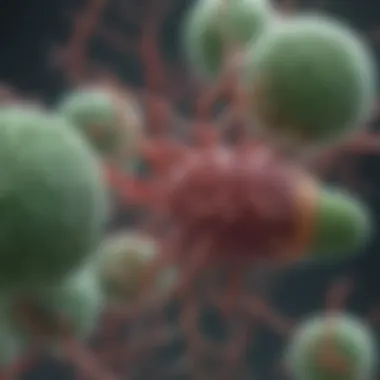Antibiotic Approaches for Pseudomonas Infections


Intro
Pseudomonas aeruginosa is a notorious bacterium widely recognized for its role in various infections, particularly among immunocompromised individuals. This organism's ability to acquire and maintain resistance against multiple antibiotics poses a significant challenge in clinical settings. As infections caused by this pathogen can lead to severe complications, understanding the current landscape of antibiotic treatments becomes imperative.
Given the multitude of antibiotic classes available, clinicians must navigate a complex array of treatment options. Each class exhibits unique mechanisms of action and varying efficacy against Pseudomonas, making the choice of therapy a nuanced decision. This guide dives deep into the spectrum of antibiotics that target this resilient bacterium, the research surrounding antibiotic resistance, and the evolving strategies that could mitigate the complexities presented by Pseudomonas infections. By dissecting these elements, a clearer understanding is achieved—vital for students, educators, researchers, and professionals grappling with this persistent pathogen.
Research Highlights
Overview of Key Findings
Recent studies underscore the combinations of antibiotic therapies that enhance the effectiveness against Pseudomonas. Notably, the use of beta-lactams alongside aminoglycosides has been highlighted for its synergistic properties.
Moreover, novel treatment strategies, such as bacteriophage therapy and antimicrobial peptides, have emerged, paving new avenues for tackling infections where conventional antibiotic choices may falter.
One critical takeaway from the research is the pressing need for routine susceptibility testing, which can significantly inform therapeutic decisions and combat resistance patterns.
Significance of the Research
Understanding the landscape of antibiotic treatment for Pseudomonas not only aids in effective clinical practice but also fosters advancements in research methodologies. The exploration of new drug combinations and alternative strategies can potentially reshape treatment paradigms, offering hope in the battle against resistant infections.
"In the realm of infectious diseases, knowledge is a form of currency—what you know can save lives."
Through comprehensive research, the dialogue surrounding antibiotic resistance and its implications on public health can be expanded, encouraging heightened awareness and proactive measures among healthcare providers.
Original Research Articles
Summary of the Article
The articles reviewed reveal a breadth of insights into the methods and approaches taken when addressing Pseudomonas aeruginosa. Multiple studies emphasize the necessity of adapting to the shifting landscape of resistance and the importance of personalized medicine, tailoring treatments to the individual patient profile.
Author Contributions
In the collective body of these research articles, various authors contribute their expertise: from microbiologists focusing on the genetic makeup of Pseudomonas, to clinical pharmacologists analyzing the efficacy of new drugs. The collaboration among disciplines demonstrates the multifaceted nature of tackling this infectious agent, highlighting the convergence of theory, research, and practical application in modern medicine.
These elements underscore the importance of ongoing research into effective treatments for Pseudomonas infections, suggesting that while challenges remain, opportunities for advancement are ripe for exploration.
Understanding Pseudomonas Aeruginosa
The significance of grasping the nuances of Pseudomonas aeruginosa extends well beyond academic interest. In the realm of clinical microbiology and infectious disease, this bacterium stands out not just for its resilience but also for its role in a multitude of infections that can range from mild to life-threatening. Understanding how it operates—its characteristics, clinical significance, and the challenges it presents—is vital for anyone involved in healthcare or research in this field.
By delving into this topic, students, nurses, physicians, and researchers gain insight into the hurdles posed by this pathogen. It equips them with the knowledge necessary to navigate the murky waters of treatment protocols and patient management, especially in hospital settings where infections often escalate.
Characteristics of Pseudomonas Aeruginosa
Pseudomonas aeruginosa is a gram-negative bacterium, notable for its striking versatility and adaptability. This organism is able to thrive in diverse environments, whether in soil, water, or even within the human body. Here are a few of its standout characteristics:
- Metabolic Flexibility: This organism can utilize an array of organic compounds as energy sources, a trait that contributes to its survival even in harsh conditions.
- Biofilm Formation: One of its most concerning traits is its ability to form biofilms on various surfaces, including medical devices. These biofilms protect the bacteria from both the host immune system and antibiotic treatment.
- Pigmentation: The production of pigments such as pyocyanin not only gives Pseudomonas its characteristic greenish appearance in culture but also plays a role in its virulence. Pyocyanin has been shown to interfere with host defense mechanisms.
- Resistance Mechanisms: This bacterium employs various mechanisms to evade antibiotic action, such as altering its cell wall and developing efflux pumps that expel drugs before they can be effective.
While these qualities make Pseudomonas aeruginosa fascinating from a scientific perspective, they also underscore its formidable role in clinical settings. Understanding these characteristics is essential for developing effective treatment strategies and improving patient outcomes.
Clinical Importance of Pseudomonas Infections
The clinical ramifications of infections caused by Pseudomonas aeruginosa are substantial. In immunocompromised individuals, such as those undergoing chemotherapy or living with chronic conditions, the risk of infection rises dramatically. The potential impacts include:
- Hospital-acquired Infections: Pseudomonas is notorious for being a culprit in nosocomial infections, particularly in ventilator-associated pneumonia, urinary tract infections, and bloodstream infections.
- Chronic Infections: Patients with cystic fibrosis frequently suffer from persistent Pseudomonas lung infections, which are intricately linked to worsening pulmonary function over time.
- Wound Infections: The ability to form biofilms makes Pseudomonas a common pathogen in wounds, especially burns, leading to severe complications and prolonged healing times.
- Treatment Complications: The increasing resistance of Pseudomonas to many antibiotics complicates treatment plans and can lead to increased morbidity and mortality.


Ultimately, Pseudomonas aeruginosa poses a significant challenge to public health, particularly given its adaptability and resistance mechanisms.
By dissecting the characteristics and clinical importance of this bacterium, we not only unravel its complexities but also lay the groundwork for more informed and effective therapeutic approaches. Understanding these elements is pivotal for healthcare professionals and researchers alike in their ongoing battle against this resilient pathogen.
Antibiotic Resistance in Pseudomonas
Antibiotic resistance in Pseudomonas aeruginosa represents a critical challenge in the management of infections caused by this resilient pathogen. The importance of addressing this topic in the discussion of treatment options cannot be overstated. Factors such as the bacterium's natural resistance mechanisms, combined with the selective pressure exerted by the widespread use of antibiotics, have exacerbated the problem.
This resistance significantly complicates clinical outcomes, making standard treatment protocols less effective. Understanding antibiotic resistance helps healthcare professionals make informed decisions about therapy regimens tailored to individual patient needs. Moreover, acknowledging the evolving landscape of resistance informs future research and the development of effective management strategies.
Mechanisms of Resistance
Pseudomonas aeruginosa employs various mechanisms to evade the effects of antibiotics. A few key mechanisms include:
- Efflux Pumps: These are proteins that actively expel antimicrobial agents out of the bacterial cell, reducing the intracellular concentration of the drugs. Pseudomonas has several efflux systems that can confer resistance to structurally distinct antibiotics.
- Enzymatic Inactivation: This involves the production of enzymes that degrade or modify antibiotics, rendering them ineffective. For example, beta-lactamase enzymes specifically target beta-lactam antibiotics, which include penicillins and cephalosporins.
- Alteration of Target Sites: Pseudomonas can modify the binding sites that antibiotics target, which significantly reduces the efficacy of these drugs. This may involve mutations in genes coding for essential proteins, making it difficult for antibiotics to bind effectively.
Through these strategies, Pseudomonas has become notably adept at surviving in diverse environments, including clinical settings.
Impact of Resistance on Treatment Outcomes
The impact of antibiotic resistance on treatment outcomes for Pseudomonas infections is profound. Patients with resistant strains often experience:
- Prolonged Hospital Stays: The difficulty in addressing resistant infections typically leads to longer hospitalizations, which can increase healthcare costs and elevate the risk of further complications.
- Higher Mortality Rates: Studies have shown that infections caused by resistant strains of Pseudomonas can result in higher mortality rates, particularly in immunocompromised patients or those with coexisting health conditions.
- Limited Treatment Options: The presence of resistance narrows the possible antibiotic choices, compelling healthcare providers to rely on more toxic or less effective agents. This selection pressure may necessitate the use of combination therapy, which itself carries risks of adverse effects and further resistance development.
Understanding these factors is paramount for clinicians as they navigate the complexities of treating infections effectively, minimizing the risk of resistance development while optimizing patient outcomes.
In summary, the nexus of antibiotic resistance in Pseudomonas aeruginosa extends beyond microbial biology; it encompasses healthcare strategies, patient safety, and the broader public health landscape. Knowing the intricacies of resistance mechanisms and their consequences lays the groundwork for improved therapeutic approaches that can be adapted in the face of this relentless foe.
Antibiotic Classes Effective Against Pseudomonas
Pseudomonas aeruginosa is a notorious pathogen notorious for its resilience against treatments. Therefore, knowing the different antibiotic classes available is crucial for healthcare professionals and researchers. This section dives into the antibiotic classes that are effective against Pseudomonas, offering insights into how they function, their advantages, and strategical considerations when prescribing them.
Beta-Lactams
Beta-lactams encompass a range of antibiotics, including penicillins, cephalosporins, and monobactams. Their structure includes a beta-lactam ring that is essential for their antibacterial efficacy. In this landscape, Beta-lactams are frequently the first line of defense when dealing with Pseudomonas infections, especially in cases of mild to moderate severity.
Penicillins
Penicillins played a groundbreaking role in antibiotic therapy. In tackling Pseudomonas infections specifically, piperacillin, a broad-spectrum penicillin, stands out.
- Key characteristic: Piperacillin's structure allows it to effectively target cell wall synthesis in bacteria.
- Benefit: It is often combined with other beta-lactams for an expanded spectrum of activity.
- Unique feature: Its synergy with beta-lactamase inhibitors significantly enhances its effectiveness against resistant strains. However, it has limitations against certain resistant types of Pseudomonas, making its use dependent on susceptibility testing.
Cephalosporins
Cephalosporins are subdivided into generations, with later generations offering improved activity against Gram-negative bacteria, including Pseudomonas. Ceftazidime is particularly significant here.
- Key characteristic: Ceftazidime is designed to bind to penicillin-binding proteins, halting bacterial cell wall synthesis effectively.
- Benefit: It shows a higher resistance to beta-lactamases than earlier penicillins.
- Unique feature: The ability of this drug to penetrate the outer membrane of Pseudomonas makes it a preferred choice. However, cephalosporins, like every other antibiotic, are not free from resistance issues, especially with Pseudomonas strains that have acquired robust beta-lactamase production capabilities.
Monobactams
Monobactams are a singular class that includes aztreonam. This antibiotic is often considered for patients who have penicillin allergies.
- Key characteristic: Aztreonam is effective against aerobic Gram-negative bacteria, providing a niche in treating Pseudomonas.
- Benefit: It has minimal cross-reactivity with penicillin, making it safer for allergic patients.
- Unique feature: The selective action of aztreonam protects normal flora, thereby minimizing the risk of superinfections. Yet, it is not a broad-spectrum antibiotic and has limited activity against other organisms.
Aminoglycosides


Aminoglycosides, such as gentamicin and tobramycin, possess unique mechanisms of action, targeting bacterial protein synthesis. They exhibit strong synergy particularly when used in combination with beta-lactams.
- Key advantage: They can effectively penetrate the outer membrane of Pseudomonas.
- Consideration: Due to potential nephrotoxicity, monitoring of kidney function is essential during treatment.
Fluoroquinolones
Fluoroquinolones, like ciprofloxacin, are notably effective against Pseudomonas.
- Mechanism: They interfere with bacterial DNA replication by inhibiting topoisomerase enzymes.
- Appreciated characteristic: Their oral bioavailability makes them convenient alternatives for outpatient therapy.
Polymyxins
Polymyxins, including colistin, represent older antibiotics returning to prominence due to their effectiveness in treating multi-drug resistant Pseudomonas.
- Characteristic: They target the bacterial cell membrane, with a unique action that disrupts membrane integrity.
- Consideration: Colistin is also known for potential nephrotoxicity, so careful monitoring is warranted.
Carbapenems
Carbapenems, such as imipenem, offer a last-resort option against resistant Pseudomonas strains.
- Key characteristic: Their broad-spectrum activity covers a wide range of bacteria.
- Consideration: With increasing resistance, particularly in healthcare settings, susceptibility testing is crucial.
Emerging Therapies for Pseudomonas Infections
Emerging therapies for Pseudomonas infections are crucial in today’s medical landscape. With the increasing prevalence of Pseudomonas aeruginosa resistance to existing antibiotics, the need for innovative treatment approaches cannot be overstated. This section delves into the latest advancements, focusing on novel antibiotics being developed and adjunctive therapies that can enhance treatment effectiveness. The significance of these emerging therapies lies not just in their ability to combat resistant strains but also in offering tailored solutions that address the specific challenges posed by Pseudomonas infections.
Novel Antibiotics in Development
Novel antibiotics are an essential part of the strategy to fight Pseudomonas infections. Researchers are exploring a range of new compounds and mechanisms that hold promise against resistant bacteria. Some of these novel antibiotics target existing pathways with fresh insight, while others introduce completely new approaches to tackling the bacteria’s unique characteristics.
One notable example is the development of fusidic acid derivatives, which demonstrated activity against various resistant strains of Pseudomonas. Additionally, teixobactin, discovered through innovative soil-based microbiology techniques, shows potential against Gram-negative bacteria. These drugs are still in the testing phase but present hope as they advance through clinical trials.
The journey of novel antibiotic development, however, is not without challenges. Regulatory pathways can be lengthy, and the efficiency of new drugs needs to be established in rigorous clinical settings. Financial investments in research and development are also significant, requiring a union between academic research and pharmaceutical enterprises to support these crucial innovations.
Key Points of Novel Antibiotic Development:
- Research Focus: New pathways targeting bacterial functions
- Innovative Approaches: Utilization of novel extraction techniques
- Clinical Trials: Ensuring efficacy and safety in diverse populations
Adjunctive Therapies
Adjunctive therapies refer to additional therapeutic strategies that complement the primary antibiotic treatment. These can either enhance the effectiveness of the antibiotics or help mitigate the adverse effects of Pseudomonas infections.
One approach currently gaining recognition is the use of bacteriophage therapy. Phages are viruses that specifically infect and kill bacteria, with potential to replace or supplement antibiotics. Studies have suggested that combining phage therapy with traditional antibiotics can significantly reduce bacterial load and help assuage the effects of biofilm formation, a common feature in Pseudomonas infections.
Another notable adjunctive therapy involves immune modulation, where specific agents are utilized to heighten the body's immune response against infections. Applying immunomodulators can potentially assist antibiotics in clearing bacterial infections more efficiently, thus reducing required dosages of traditional therapies.
Benefits of Adjunctive Therapies:
- Enhanced Efficacy: Synergistic effects leading to improved outcomes
- Targeted Action: Utilizing immune response mechanisms
- Reduced Resistance Development: Aiming to limit the pressure on antibiotics
"Emerging therapies provide hope where conventional treatment options falter, paving the way for a future where we can effectively tackle the growing menace of antibiotic resistance."
As we continue to explore these exciting directions in Pseudomonas treatment, it becomes increasingly clear that integrating novel antibiotics with adjunctive therapies is essential to outmaneuvering the evolving challenges presented by this formidable pathogen.
Current Guidelines for Treatment


In the battle against Pseudomonas infections, guidelines serve as a critical beacon. They are more than just recommendations; they distill years of research, clinical experience, and evolving knowledge into actionable insights for treating this formidable pathogen. The guidelines are essential because they help healthcare professionals navigate the complexities associated with antibiotic selection and optimize patient outcomes. Furthermore, they keep practitioners informed about the latest protocols, encouraging a unified approach that can mitigate the impact of antibiotic resistance, which is particularly pronounced in Pseudomonas aeruginosa.
Recommendations from Health Organizations
Several respected health organizations issue guidelines for the treatment of Pseudomonas infections, each contributing valuable recommendations. For instance, the Infectious Diseases Society of America (IDSA) provides a framework that focuses on the necessity of timely and appropriate antibiotic therapy. Their guidelines often emphasize a couple of core principles:
- Early Detection: Prompt diagnosis can significantly influence treatment success. Tools like microbiological cultures and susceptibility testing are highlighted. These help tailor the right antibiotic choices swiftly based on local resistance patterns.
- Combination Therapy: Many recommendations advocate for the use of combination therapies, especially in severe infections. This is due to Pseudomonas's notorious multidrug resistance—for instance, using a beta-lactam with an aminoglycoside may increase efficacy against resistant strains.
Moreover, organizations like the World Health Organization (WHO) continue to spotlight the importance of stewardship programs aimed to optimize antibiotic use, preventing the escalation of resistance. This guides practitioners to consider not just individual patient needs but broader public health implications.
"The choice of antibiotic in treating Pseudomonas infections must be informed by local epidemiology and resistance data, ensuring the best chance of treatment success."
Personalized Treatment Approaches
Personalized treatment approaches are gaining traction as a response to the unique challenges presented by Pseudomonas infections. This method underscores the importance of tailoring treatment plans to the individual characteristics of each patient, rather than relying on a one-size-fits-all strategy. Such an approach can account for various factors:
- Patient Factors: Age, comorbidities, and previous antibiotic exposure should be considered when choosing a therapy. For example, older adults may have different pharmacokinetics, requiring adjustments in dosing.
- Microbial Factors: Understanding the specific resistance pattern of the Pseudomonas strain is vital. Techniques such as whole-genome sequencing can help identify resistance mechanisms, potentially guiding the selection of more effective agents.
- Clinical Context: The site of infection greatly influences treatment options. For instance, pulmonary infections may necessitate different therapies compared to urinary tract infections.
Tailoring therapy not only aims to enhance effectiveness but also minimizes side effects and promotes better adherence by aligning the treatment with a patient's unique circumstances. This is increasingly important as more evidence supports the benefits of customizing antibiotic regimens, making it a focal point in Pseudomonas management.
Future Directions in Pseudomonas Research
Understanding the future directions in Pseudomonas research is crucial for advancing treatment options and overcoming the persistent challenge of antibiotic resistance. As Pseudomonas aeruginosa continues to adapt and evade current therapies, research efforts are pivotal in discovering innovative methods to combat infections. This section will delve into key trends and focus areas that shape the future landscape of treatment strategies involving Pseudomonas.
Research Trends and Focus Areas
Research into Pseudomonas infections is gaining momentum, fueled by the urgent need for more effective therapeutic options. Here are some of the trends and focus points currently being explored:
- Drug Discovery: New compounds are continuously being tested for their efficacy against resistant strains. High-throughput screening of chemical libraries is becoming more common, allowing for the rapid identification of promising candidates.
- Combination Therapy: Researchers are exploring various combinations of existing antibiotics to enhance efficacy against multi-drug resistant strains. This approach can potentially exploit synergies between different drugs, improving treatment outcomes.
- Vaccines: The development of a vaccine against Pseudomonas is an ongoing goal. Successful vaccines could prevent infections in high-risk populations, significantly reducing disease burden.
- Phage Therapy: Utilizing bacteriophages to target and kill Pseudomonas is emerging as an innovative treatment avenue. This approach harnesses natural predators of bacteria, which could offer a targeted alternative or adjunct to traditional antibiotics.
- Biofilm Research: Since Pseudomonas often forms biofilms, research into disrupting these structures is critical. Understanding the biochemical mechanisms of biofilm formation and maintenance could lead to novel treatments that prevent chronic infections.
In summary, these focus areas are pivotal as they shape the future research landscape, aiming to outsmart the adaptive capacities of Pseudomonas and improve patient outcomes.
The Role of Genomics in Treatment
Genomic advancements are opening new doors in the realm of understanding Pseudomonas aeruginosa infections. This technology offers unprecedented insights into the genetic makeup of the pathogen, facilitating targeted therapies and personalized medicine.
- Genome Sequencing: With the decrease in cost and increase in speed of genome sequencing, researchers can now analyze the genetic variances among different strains of Pseudomonas. This allows for a better understanding of resistance mechanisms.
- Targeted Antibiotic Development: Knowing the specific genetic factors that confer resistance can help develop new antibiotics designed to target these pathways. This specificity may lead to higher efficacy and reduced side effects.
- Understanding Host Interactions: Genomic research is uncovering how Pseudomonas interacts with the human host. Insights into these interactions could illuminate novel therapeutic targets, leading to the development of adjunct therapies that fortify the immune response.
"Leveraging genomics not only enhances our understanding of Pseudomonas but also aids in developing tailored treatment solutions to combat its notorious resistance strategies."
The integration of genomics into treatment protocols promises to revolutionize how we approach infectious diseases caused by Pseudomonas, ultimately improving patient care and outcomes.
Closure
In the realm of infectious diseases, few pathogens present a challenge quite like Pseudomonas aeruginosa. This, often, aggressively opportunistic bacterium has solidified its reputation as a formidable adversary in clinical settings, particularly due to its well-known tendency for developing resistance to antibiotics. Thus, the importance of effectively managing Pseudomonas infections cannot be overstated.
Summary of Key Points
As we review the intricacies of this article, several essential aspects emerge:
- Nature of Pseudomonas: Understanding its unique characteristics and clinical significance helps in comprehending the need for targeted treatments.
- Antibiotic Resistance Mechanisms: The mechanisms through which these bacteria develop resistance highlight the challenges faced in treatment and the necessity for innovative approaches.
- Diverse Antibiotic Classes: Familiarity with various antibiotic classes, such as beta-lactams, aminoglycosides, and polymyxins, equips healthcare professionals with the knowledge needed for informed decision-making in therapy.
- Emerging Therapies and Research Trends: The exploration of new therapies and research into antibiotic resistance not only enhances our therapeutic options but also reinvigorates hope in the battle against this persistent infection.
The thorough examination of these points paints a comprehensive picture of the current state of knowledge and practice surrounding Pseudomonas infections.
Importance of Ongoing Research
Continuous research in this field is not merely an academic exercise; it is a vital pursuit that embodies the quest for more effective treatments. The landscape of bacterial resistance is ever-evolving, and with that, new strains of resistance continually surface. Ongoing research is essential for:
- Identifying Novel Treatment Options: Developing new antibiotics or alternative therapies could pave the way for effective treatment plans against resistant strains.
- Understanding Genomic Impacts: The role of genomics in understanding and treating these infections is critical for tailoring individualized therapy.
- Anticipating Future Challenges: By staying ahead of resistance trends, researchers and practitioners can prepare strategies to mitigate potential setbacks in managing infections.
As Pseudomonas aeruginosa continues to challenge the medical community, the dedication to enhanced research efforts remains a beacon of hope. Each study, every trial—these are the building blocks towards conquering this insidious infection, ultimately ensuring better healthcare outcomes for patients worldwide.







